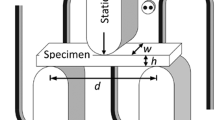Abstract
The α − β transition of quartz was successfully observed with using a single sample by means of the rectangular parallelepiped resonance (RPR) method. An oriented rectangular parallelepiped of α-quartz single crystal was prepared and the resonant frequencies of 30–11 vibrational modes were measured from room temperature to 700°C. The softening of quartz crystal was observed as the significant reduction of resonant frequencies near the α–β transition. The present study is the first application of the RPR method to the study of phase transition. The complete set of elastic constants of α- and β-quartz were determined as a function of temperature by the least-squares inversion of the measured frequency data obtained by a single run. This is a merit yielded by the RPR method. It is shown near the α − β transition in both α- and β-quartz that the elastic parameters decrease proportionally to |T−T 0|−n, where T is temperature and T 0 is the transition temperature, 573.0°C for α-quartz and 574.3°C for β-quartz. It was also seen that linear incompressibilities K 1 = (C 11 +C 12 +C 13)/3 and K 3 = (C 33 +2C 13)/3 decrease rapidly toward the transition, whereas, shear moduli C 44, C S1 = (C 11 +C 33 -2C 13)/4 and C S3 = (C 11 -C 12)/2 = C 66 decrease only slightly. The shear modulus C S3 = C 66 increased slightly in α-quartz. The elastic properties of isotropic aggregate of quartz were calculated, and it is shown that the longitudinal wave velocity significantly decreases at the α − β transition, whereas, the shear wave velocity decreases only slightly.






Similar content being viewed by others
References
Ackermann RJ, Sorrell CA (1974) Thermal expansion and the high-low transformation in quartz. I. High-temperature X-ray studies. J Appl Cryst 7:461–467
Atanasoff JV, Hart PJ (1941) Dynamical determination of the elastic constants and their temperature coefficients for quartz. Phys Rev 59:85–96
Bechmann R (1958) Elastic and piezoelectric constants of alpha-quartz. Phys Rev 110:1060–1061
Goto T, Anderson OL (1988) Apparatus for measuring elastic constants of single crystal by a resonance technique up to 1825 K. Rev Sci Instrum 59:1405–1408
Goto T, Anderson OL (1989) Elastic constants of corundum up to 1825 K. J Geophys Res 94:7588–7602
Hearmon RFS (1956) The elastic constants of anisotropic materials II. Adv Phys 5:323–382
Kammer EW, Pardue TE, Frissel HF (1948) A determination of the elastic constants for beta-quartz. J Appl Phys 19:265–270
Koga I, Aruga M, Yoshinaka Y (1958) Theory of plane elastic waves in a piezoelectric crystalline medium and determination of elastic and piezoelectric constants of quartz. Phys Rev 109:1467–1473
McSkimin HJ, Andreatch P, Thurston RN (1965) Elastic moduli of quartz versus hydrostatic pressure at 25 and −195.8°C. J Appl Phys 36:1624–1632
Oda H, Suzuki I, Ohno I (1993) Partial derivatives of eigenfrequencies of a rectangular parallelepiped and a sphere of elastically anisotropic solid. J Phys Earth 41:271–289
Ohno I (1976) Free vibration of a rectangular parallelepiped crystal and its application to determination of elastic constants of orthorhombic crystals. J Phys Earth 24:355–379
Ohno I (1990) Rectangular parallelepiped resonance method for piezoelectric crystals and elastic constants of alpha-quartz. Phys Chem Minerals 17:371–378
Ohno I (1994) Temperature variation of elastic properties of α-quartz up to the α-β transition. J Phys Earth 43:157–169
Ohno I, Yamamoto S, Anderson OL (1986) Determination of elastic constants of trigonal crystals by the rectangular parallelepiped resonance method. J Phys Chem Solids 47:1103–1108
Scott JF (1972) Soft-mode spectroscopy: experimental study of structural phase change. Rev Mod Phys 46:83–127
Zubov VG, Firsova MM (1962) Elastic properties of quartz near the α-β transition. Soviet Phys Cryst 7:374–376
Acknowledgements
The authors thank the reviewers, Drs. D. Isaak, S. Senogeikin and D. Lakshtanov. Their comments were very much helpful to improve the manuscript.
Author information
Authors and Affiliations
Corresponding author
Rights and permissions
About this article
Cite this article
Ohno, I., Harada, K. & Yoshitomi, C. Temperature variation of elastic constants of quartz across the α - β transition. Phys Chem Minerals 33, 1–9 (2006). https://doi.org/10.1007/s00269-005-0008-3
Received:
Accepted:
Published:
Issue Date:
DOI: https://doi.org/10.1007/s00269-005-0008-3




